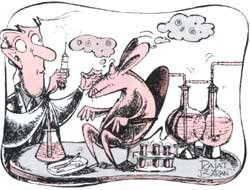Pressure play
 MUCH evidence in recent years has proved what folk wisdom and traditional medicinal practices had long believed. Our immune, nervous and hormonal systems are all linked. A number of studies with viral and bacterial agents have shown that the degree of infection can be modulated by interactions between these three systems. For instance, stress can affect wound healing; and traumatic experiences like the death in the family can predispose individuals to viral infection. All this makes it likely that the manner in which the immune system reacts to a challenge might depend on hormonal levels and the mind. David Padgett and colleagues of Ohio State University, USA, offer new evidence of this hypothesis, albeit in mice (Proceedings of the US National Academy of Sciences, Vol 95, p7231-7235).
MUCH evidence in recent years has proved what folk wisdom and traditional medicinal practices had long believed. Our immune, nervous and hormonal systems are all linked. A number of studies with viral and bacterial agents have shown that the degree of infection can be modulated by interactions between these three systems. For instance, stress can affect wound healing; and traumatic experiences like the death in the family can predispose individuals to viral infection. All this makes it likely that the manner in which the immune system reacts to a challenge might depend on hormonal levels and the mind. David Padgett and colleagues of Ohio State University, USA, offer new evidence of this hypothesis, albeit in mice (Proceedings of the US National Academy of Sciences, Vol 95, p7231-7235).
The herpes simplex virus is a common infective agent in humans and mice. Padgett's group studied trie role of stress on releasing a strain of the virus (HSV-1) from latency in mice. Anaesthetised male mice were infected by lightly dabbing one eye with a solution of nsv-1, which infects the corneal layer of the eye. Later, to estimate the level of infection, a second surface swab of the cornea can be taken, this time with a sterile swab, and the material can be tested for infection on a plate of cultured cells. The level of infection can be estimated by measuring how a diluted suspension can still harm the cell culture. It took four to five weeks for the infection to be established and become latent. At this time, the mice were exposed to a number of possible sources of stress. The mice were then distributed in various groups and their interactions were monitored. Within each group, careful observation enabled aggressive and submissive individuals to be identified. The stress involved exchanging top-ranking aggressive males between two groups.
The results were striking. A latent infection was established within about one month of viral infection - latent, because no viral particles were picked up by the sterile swab. Exposure of the affected eye to ultraviolet light resulted in a reactivation of the virus, as shown by the sterile swab picking up a large number of viral particles. This holds true for many viruses and is believed to be caused by damage to the DNA of the host. Restraint-stress made little difference to the virus, even though the degree of stress in these animals was high enough. However, when a psychological stress was used, the outcome was different. Animals whose social hierarchy was disrupted showed a dramatic reactivation of the latent viral infection. This was true especially for mice which were previously dominant and were now suddenly exposed to a new social environment.
It might seem simple to extrapolate the results of a study conducted on mice directly to humans. And yet, it would be surprising if social stress did not act in a roughly similar manner in the case of humans as well. It is known that stress can activate the sympathetic nervous system and can cause the release of catecholamines into the circulation. Psychological stress can give rise to negative mental and emotional states which not only result in a physiological ':djustment" to the stress, but may do so at the cost of affecting the ability of the immune system, either to respond to a new infection or to keep an old infection under check.
Related Content
- Examining the efficiency of biodiversity finance action plan across the Indian megacities
- World energy investment 2022
- Rebooting renewable energy certificates for a balanced energy transition in India
- Charting a course for decarbonizing maritime transport: summary for policymakers and industry
- Spotlight on adolescent health and well-being
- Dividing the water, sharing the benefits: lessons from rural-to-urban water reallocation
